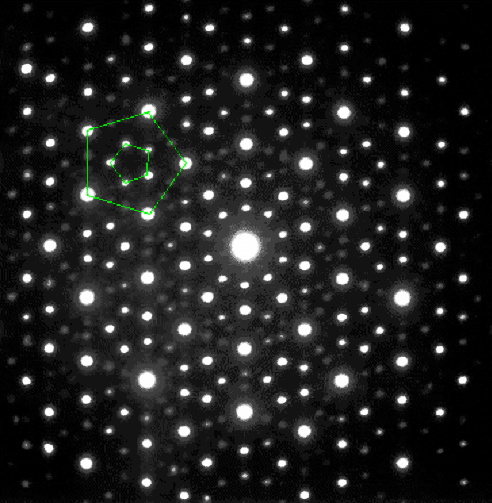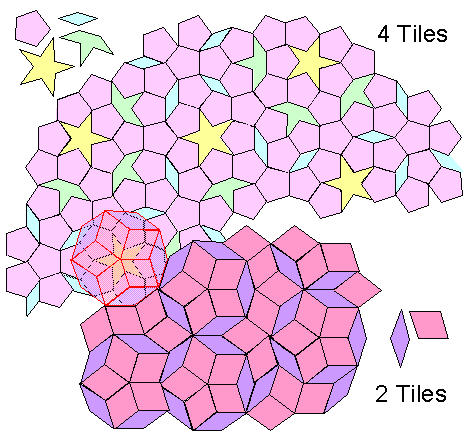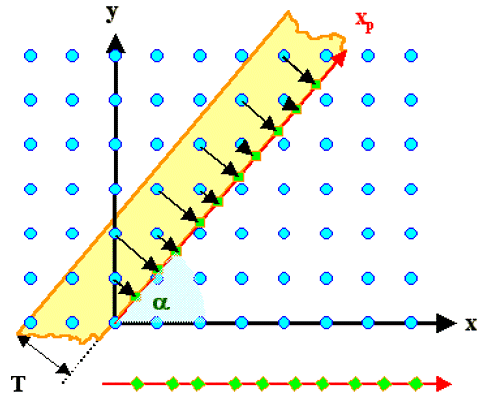|
Quasi Crystals |
|
History and Basics |
 |
You don't have to be a genius to realize that you can't completely tile your two-dimensional
bathroom floor or walls with regular five-sided tiles or pentagons. Hexagons - yes. Equilateral triangles, squares, and
rectangles - yes; see the figure below. |
|
 |
You don't have to be a genius either to realize that you cannot "tile"
three-dimensional space (akin to filling out a volume) with regular five-sided bricks (called dodecahedrons) either. Rectangular
bricks - yes. Tetrahedrons - yes. Others? Who knows. But dodecahedrons - definitely no. |
| |
|
|
|
 |
| Tiling the plane. It is simply not possible with pentagons |
| "Tiling" or bricking up space with dodecahedrons is simply not possible either. A
dodecahedron is shown in the upper right corner. |
|
| |
| |
|
 |
You don't have to be a genius either to know that the diffraction
pattern of regular crystals therefore can never have a five-fold symmetry.
But you need to know a bit about crystals and Fourier transformations though, or you must now look at this
module. |
 |
When in 1982 Dan Shechtman
observed a diffraction pattern like the one below, he was flabbergasted, to put it mildly. His specimen was a rapidly cooled
alloy of aluminum (Al) and Manganese (Mn), nothing particularly exciting. The presence of a diffraction pattern proved that
the material was crystalline, i.e. with a regular arrangement of its atoms, and the 5 or 10 fold symmetry of the diffraction
pattern proved that there must be an arrangement of building blocks that was simply impossible according to common and well
justified believe. |
|
 |
Of course, nobody believed Shechtman at first. His boss suggested that he quit, extremely
famous Nobel prize winner Linus Pauling pontificated that "there
are no quasicrystals, only quasiscientists"; journals refused to print his papers. In 2011 Dan Shechtman was awarded
the Nobel prize. |
|
| |
| |
 |
| Diffraction pattern of a quasicrystal (Electron microscope) |
| Note the "impossible" 10-fold rotational symmetry. There are lots of pentagons, two
are outlined in green. |
|
| |
| |
 |
The break-through occurred in 1984 after some open-minded scientists adopted Shechtman's
results. It also became clear that the solution to the obvious problem was already at hand, since more mathematically inclined
scientists had already dealt with the problem theoretically years before Shechtman's discovery. |
| |
 |
In particular, famous Roger Penrose
had shown in 1974 how to tile a plane in a way that provided regularity and a five-fold
symmetry. What was lost was the usual translation symmetry
of normal crystals, i.e. the property that nothing changes in the pattern if you just move it in the plane.
The figure
below illustrates this "Penrose tiling". |
| | |
|
|
|
 | | Penrose tiling and quasicrystals. |
|
| |
| |
|
 |
Penrose used 4 differently shaped tiles but you can get away with just two types as shown.
Just connect the centres of the old tiles as illustrated in the overlapping part.
There are a lot of five-fold structures
in this tiling, and there is a lot of regularity.
Now do the whole thing with properly
chosen bricks in three dimensions, and you have the structure of the quasicrystals that Shechtman observed.
Scientists
have made a lot of quasiscrystals by now; even Mother Nature makes them. They have rather peculiar properties but we still
have to find major applications for this new class of materials |
| | |
|
|
Boggling the Mind |
 |
Now lets give the difficult part a quick look. First, we ask ourselves if, maybe,
you could tile the plane in a quasicrystal pattern with just one tile? It is clear to
you that this question has a defined answer: yes or no! |
|
 |
It is probably not so clear to you that this question belongs to the class of perfectly legitimate
questions with a definite yes / no answer for which it is impossible to find the answer in a systematic
way, i.e. by an algorithm. Mathematicians have proved that with mathematical rigor.
You may happen to find the answer somehow, for example by lucky guessing, but you will never be able to program a computer
to find the answer.
So far, by the way, nobody has found the answer to the question above. It is rather unlikely that
one tile will do, but who knows? |
 |
Now to the really weird part. Quasicrystals actually result from perfectly legitimate
real crystals with translation symmetry and everything - if you construct these crystals
in six
dimensions. Mathematicians have no problems to do that with equations, it just boggles the mind a bit to imagine
it. |
|
 |
All you need to do is to construct a nice six-dimensional crystal. Then you project some of
its lattice points onto our common three-dimensional space in some proper way. You can't imagine that? I can't either.
But it's just like projecting three-dimensional objects onto two-dimensional space, just a bit more involved. Take a sphere,
for example. Project it onto a plane and you have a circle for all projection geometries. Project a cube and you can get
squares, rectangles and hexagons, depending on the projection geometry. |
|
 |
Let's do it in an even simpler way. We take a lattice in two
dimensions and project it onto one-dimensional space, i.e. on a line. The figure below
illustrates how it is done: |
| |
| |
| |
 |
| Generating quasicrystals by projection from higher dimensions. |
|
| |
| |
|
 |
The general recipe is simple:
- Produce a two-dimensional (six-dimensional) lattice / crystal as shown.
- Draw a one-dimensional (three-dimensional) space into the two-dimensional (six-dimensional)
one. Make sure that there is some irrational relation. A vector along the one-dimensional line might have the components
[1, (2)½], for example. The one-dimensional line then will never run across a lattice point because of this.
- Project the lattice points found inside some one-dimensional (three-dimensional space)
distanceT to the line onto the line (three-dimensional space).
- You have produced a quasicrystal.
|
|
 |
Look at the sequence of projected points on the red line above. There is clearly some regularity
but the pattern never repeats; it is a one-dimensional quasicrystal.
If you have a lot of free time, you can now do
the same thing for a three-dimensional crystal projected onto a two-dimensional space, i.e. a plane. Please send me the
drawings after you are done. |
 |
Now you are thinking that this is pretty crazy but just what you would expect
of the nerdiest of the nerds, the mathematicians. Surly, this stuff has no bearing on real quasicrystals that you can buy
and touch? |
|
 |
Not so. Lattice defects like dislocations,
one should think, can only exist in real three-dimensional crystals. Amazingly enough, with an electron microscope, we see
things that look like dislocations and behave like dislocations also in quasi crystals.
These things are dislocations. But, as it turns out, only if we associate a six -dimensional
vector with them, in contrast to dislocations in normal crystals, where a three-dimensional vector is sufficient.
|
 |
If you now admit that Dan Shechtman got his Nobel prize for rather good reasons,
I will rest my case. |
| |
| |
© H. Föll (Iron, Steel and Swords script)



